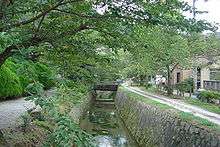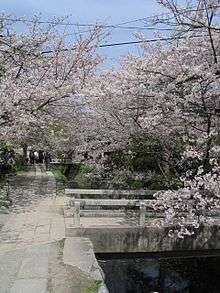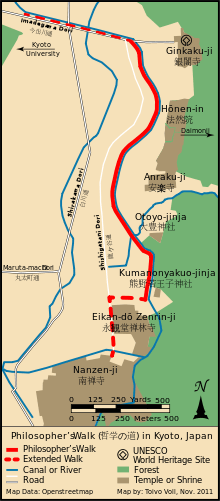Philosopher's Walk
The Philosopher's Walk (哲学の道, Tetsugaku-no-michi, lit. Path of Philosophy) is a pedestrian path that follows a cherry-tree-lined canal in Kyoto, between Ginkaku-ji and Nanzen-ji. The route is so-named because the influential 20th-century Japanese philosopher and Kyoto University professor Nishida Kitaro is thought to have used it for daily meditation. It passes a number of temples and shrines such as Hōnen-in, Ōtoyo Shrine, and Eikan-dō Zenrin-ji. It takes about 30 minutes to complete the walk, although many people spend more time visiting the sights along the way. On the northern part of the walk, there are good views of the nearby Daimonji. The walk is a popular destination for tourists and locals, especially during hanami.



Media Appearances
The Philosopher's Walk is the setting for the video game Haiku by Flaminia Grimaldi. The art game's opening screen includes the line, "You sit by the river Tetsugaku-no-Michi."[1] In the game, a player chooses among various lines of poetry to craft a haiku.
External links
| Wikimedia Commons has media related to Philosopher's Walk. |
References
- Grimaldi, Flaminia. "Haiku". Retrieved March 8, 2019.
Clancy, Judith (2008). Exploring Kyoto: On Foot in the Ancient Capital. Stone Bridge Press. p. 50. ISBN 978-1-933330-64-8.
Richmond, Simon; Jan Dodd; Sophie Branscombe; Robert Goss; Jean Snow (2011). The Rough Guide to Japan. Penguin. ISBN 978-1-84836-615-2.
Rowthorn, Chris (February 2012). Kyoto. Lonely Planet Publications Pty Ltd. ISBN 978-1-74179-401-4.
Masuda, Koh (1991). Kenkyusha's New Japanese-English Dictionary. Kenkyusha Limited. ISBN 4-7674-2015-6.
Created in 1986. It is a 30 minute walk.